
* The KC-135, along with the set of trials machines, also led to a series of "EC-135" flying command posts, mostly for the strategic nuclear command & control mission, with these aircraft flying on alert through the Cold War. There was also a series of specialized "RC-135" reconnaissance platforms, which remain in service.
* Early on, the KC-135 was adapted to the "airborne command post (ACP)" mission, in the service of the Strategic Air Command (SAC). The main idea was that there needed to be a command post that could stay aloft and ride out a nuclear strike, to then direct retaliation. In consequence, a number of KC-135As were kitted up with command & control systems, with at least one remaining in the air at all times. They went into operation in 1961; they were redesignated "EC-135A" in 1965.
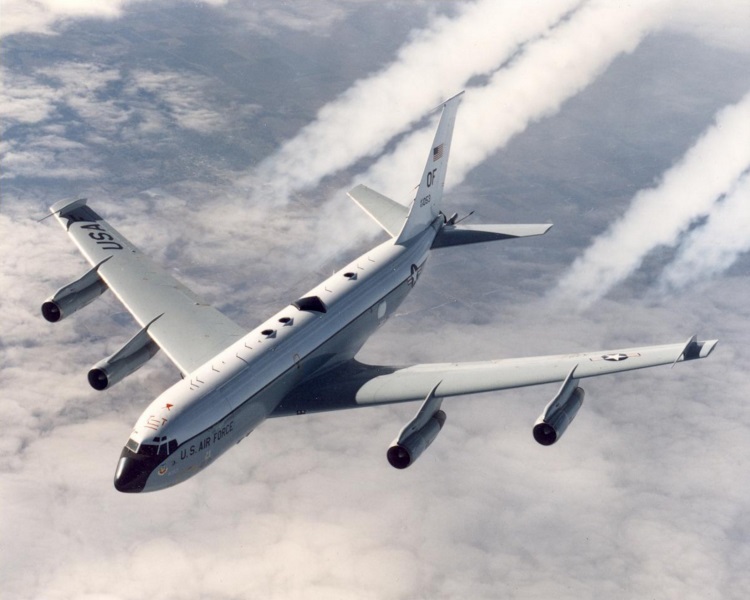
They were the first in a series of EC-135 variants. They generally operated in the context of a strategic nuclear response system -- the "Post-Attack Command & Control System (PACCS)" -- that remains largely secret, but whose overall organization is known. Flight elements of that system, the aircraft collectively known as "Cover All", included:
In addition, there were "Head Dancer" EC-135 ACPs, used to coordinate overseas fighter deployments and other special air missions. They were not part of the PACCS, and had nothing directly to do with nuclear command & control.
As with the test & trials KC-135s, trying to sort out EC-135 variants is very difficult. Secrecy is one reason the trail is confused -- but in addition, one EC-135 variant might be able to carry out different missions, possibly with some variation in equipment fit as per mission, and with configurations changing over time. Another issue was that different variants were often difficult to tell apart. They invariably had a litter of antennas over the fuselage, and often had an HF antenna above each wingtip -- though not all EC-135s had the wingtip antennas.
Sometimes the EC-135s had dual wire antennas running from the wings back to the tail, and sometimes they had a long "towed wire antenna (TWA)", spooled out from a fairing under the fuselage forward of the landing gear. The TWA supported very low frequency (VLF) communications; VLF could penetrate into the ocean, allowing communications with ballistic missile submarines AKA "boomers". The EC-135s usually retained tanker gear, and were often fitted with IFR sockets so they could stay in the air an extended time.
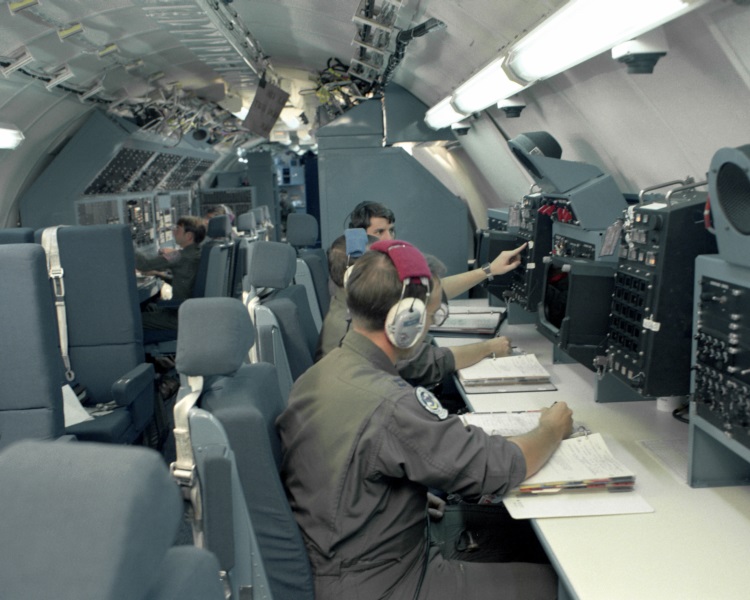
Along with the flight crew, they carried a command and communications staff. Sometimes they were used as Air Force VIP transports, as tankers if they retained tanker kit, and it seems for other roles. Any one aircraft might also have been converted to other KC-135 variants, even back to a tanker standard. In case, the ACP EC-135s included:
* Along with the ACP EC-135s, there were also four C-135Bs and eight C-135As converted, as "EC-135B" and "EC-135N" machines respectively, to the ARIA spacecraft tracking role, also mentioned earlier, where "ARIA" originally stood for "Apollo Range Instrumentation Aircraft", later "Advanced Range Instrumentation Aircraft". They had effectively nothing to do with the USAF flying command posts, and amounted to an operational class of their own.
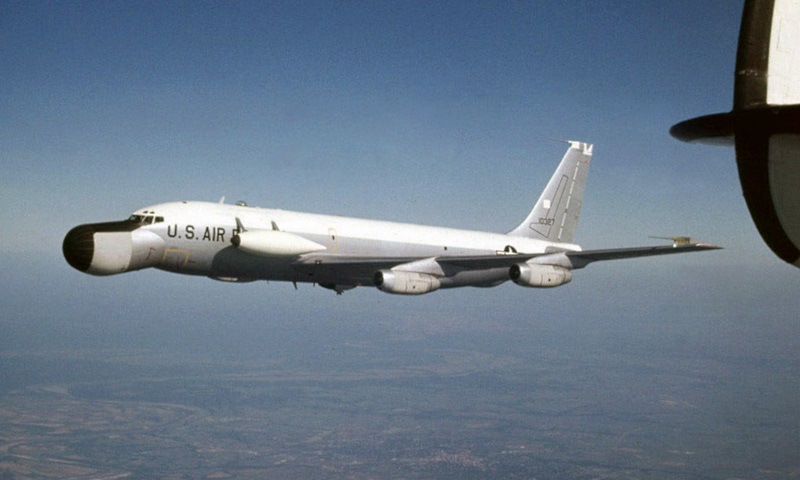
They were kitted with a modular "Prime Mission Electronic Equipment (PMEE)" payload module, featuring telemetry, voice communications, and recording gear. They featured a bulbous "platypus" nose, and did not have tanker kit. Four of them could carry a Northrop "Airborne Lightweight Optical Tracking System (ALOTS)" pod, mounted on the left side of the fuselage, forward of the wing. Along with four flight crew, they carried a mission commander and at least eight techs -- sometimes well more techs for long missions, the aircraft presumably being fitted with rest facilities. They were flown by NASA to support space missions as an element of the NASA spaceflight tracking and communications network, covering oceanic "holes" that ground or ship tracking stations couldn't deal with. The fleet reached full operational capability in 1968.
There were only seven PMEEs, so one of the aircraft was a spare, to be refitted with a PMEE when another machine was grounded. Once again as discussed earlier, in the 1980s four second-hand 707 jetliners, obtained from American Airlines, were also converted to ARIA configuration, being designated "EC-18B". The size of the fleet remained the same, as did the number of PMEE modules; the old jetliners were used to allow KC-135 ARIAs to be converted to more important uses. Since they started life as jetliners, the EC-18Bs were easily distinguished by their passenger windows. From 1983, the NASA ground network was gradually replaced by a space network, based on the Tracking & Data Relay Satellites (TDRS). Some of the ARIAS remained in service in the 1990s, apparently to support missile tests as telemetry relays.
Along with the ARIAs, there were four conversions of C-135Bs to "Telemetry Range Instrumentation Aircraft (TRIA)" configuration, which were flown to complement the ARIAs. They had the big ARIA nose, but were apparently a subset of ARIA, being focused on telemetry, and couldn't carry ALOTS. They are somewhat puzzling, apparently having been a short-term stopgap; they were withdrawn from the tracking role in the early 1970s, with two converted to ARIAs as replacements, and two adapted to other roles.
* Another oddball was the "KC-135A-VIII", which was kitted up for the radio relay mission for PACAF, relaying signals from Lockheed EC-121T Warning Star AEW aircraft, supporting combat search & rescue missions, and performing other theatre radio relay tasks. They were easily recognizable, having a distinctive row of stubby UHF antennas along the spine of the aircraft.
There were seven conversions, these machines being known under the program name of "Combat Lightning"; they retained their tanker capability, using a drogue attachment to support USAF and Navy tactical aircraft without boom refueling capability. The KC-135A-VIIIs, it seems, were "poor man's" EC-135Ls; PACAF had actually wanted EC-135Ls, but SAC didn't want to part with them -- though two EC-135Ls were used as an interim capability until the Combat Lightning EC-135As came online.
The last airborne alert of Looking Glass was in 1990; a Looking Glass had been in the air at all times from 1961. Such EC-135s as had survived, or not been converted to other variants, were retired during the 1990s. As mentioned above, NEACP was taken over by the E-4; while the Looking Glass mission was taken over by the E-6B Mercury. The Head Dancer KC-135s were, it seems, obsoleted by KC-135 tankers kitted up to handle that mission. During the 1990s, one KC-135E was fitted up as some kind of ACP for Strategic Command (STRATCOM), the joint command that replaced SAC in 1992.
BACK_TO_TOP* From early on, the KC-135 was seen as the basis for a reconnaissance / intelligence platform. As with the EC-135s, tracing out the story of the "RC-135" machines is tricky, largely because of secrecy, but also because there was a mishmosh of variants, some of them temporary, with any one machine often being seen in an evolving series of variants.
In the early 1960s, three KC-135As were modified by Big Safari under the "Speed Light" program to monitor foreign nuclear tests; they had no special designation. They flew out of Shemya Island in the far western reaches of the Aleutians, where they could keep an eye on Soviet tests in Siberia. The air base on Shemya was originally just "Shemya AFB", but later it would be "Eareckson Air Station (AS)". It operated as a remote location for Eielson AFB, near Fairbanks, Alaska. Little is known about the details of the configuration of these aircraft.
One of the Speed Light KC-135s observed the Soviet "Tsar Bomb" detonation on 30 October 1961. The Tsar Bomb was announced to have a yield of 100 megatons of TNT, but it turned out to have a yield of 58 megatons, still making it the most powerful Bomb ever. The KC-135A was scorched, and would have been in big trouble had the yield been as advertised.
They -- and a fourth machine converted from a KC-135A, after a 1967 crash -- were updated in the later 1960s under the "Rivet Stand" and then "Busted Jaw" programs to the "KC-135R" configuration, which had nothing in particular to do with the KC-135Rs with CFM engines. A photo of one showed it to have three sets of "towel rack" antennas, each consisting of three tandem stand-offs joined by an aerial rod -- plus an antenna fairing under the fuselage forward of the wing, other antennas scattered here and there, and small windows for cameras or instruments.
However, it appears the mission kit of the Rivet Stand KC-135Rs was variable, even varying from mission to mission, with one of them sporting an extended "hog" nose -- often if not universally seen on RC-135s, not seen on other KC-135 variants. They operated globally, being based out of Offutt AFB in Nebraska under the 55th Reconnaissance Wing. Offutt would become the central home base of the RC-135s, though they would also operate out of other bases all over the world, notably Shemya, Kadena on Okinawa, Upper Heyford in the UK, and Riyadh in Saudi Arabia.
One of the KC-135Rs was modified to the "KC-135T" configuration under the "Rivet Jaw" program. Despite the "T" suffix, it was not a trainer, instead being a SIGINT machine. This variant had the hog nose, antenna fairings forward of the tailplanes, a large fairing under the fuselage, and various antennas. It was later further updated to the "RC-135T" configuration under the "Rivet Dandy" program, with this machine eventually indeed becoming a trainer. The two remaining KC-135Rs were converted into tankers in the 1970s. The RC-135T crashed into a mountain while practicing approaches to Valdez Municipal Airport in Alaska on 25 February 1985, all three on board being killed. The wreck was not found until summer.
The first KC-135s to be built specifically for the reconnaissance role were four "RC-135A" machines, produced in 1964 and 1965. The program was anything but smooth; nine were originally ordered, but only four survived budget cuts, and development problems meant they didn't enter provisional service until 1969. They were specifically built for the photo-mapping mission, having an array of survey cameras shooting out the belly of the forward fuselage. They shot through a flat glass plate that was protected by a sliding door, and also carried other geodetic survey instruments. They didn't have tanker booms, featuring a fuel-dump tube where the boom was supposed to be. The program never really got on track, being terminated in 1972, with all four machines then being modified to KC-135D tanker configuration.
The "RC-135C" was a signals intelligence (SIGINT) platform, with ten originally built by Boeing in 1964 and 1065 as "RC-135B" machines, to be upgraded under the "Big Team" program before delivery. They had TF33 engines but no tanker kit. They had widely varying configurations; at least in some cases, they had "cheek" arrays, and were accordingly called "Chipmunks". In the early 1970s, three were converted to RC-135U configuration, the rest to RC-135V configuration -- discussed later.

In the early 1960s, there were also three conversions of C-135As to a SIGINT configuration under the "Office Boy" program, these machines being designated "KC-135A-II". They flew out of Eielson / Shemya as part of the "Cotton Candy", later "Burning Candy", operation. Little else is known about them, except that in 1965 and 1966 they were updated to an improved "RC-135D" SIGINT configuration under the "Rivet Brass" name, and returned to "Burning Candy" service. They had the hognose, plus sausage-shaped fairings on each side of the forward fuselage -- but aside from wingtip antennas, no "antenna farms". All three were modified to KC-135A (ARR) configuration in the early 1970s.
There were six "RC-135M" conversions from C-135Bs in 1967 and 1968, for the "Rivet Card" and "Rivet Quick" programs. They were SIGINT machines, featuring the hog nose, teardrop fairings forward of the tail, and prominent ventral antennas. RC-135Ms participated in the Vietnam War under the "Combat Apple" operation, flying out of Kadena to keep an eye on North Vietnam. All six were converted to RC-135Ws in the early 1980s.
* The "RC-135S" was intended to track Soviet missile tests. The type began life in as a 1960 conversion of a KC-135A under the "Nancy Rae" program, this being one of the very first KC-135 reconnaissance conversions. The IFR boom was deleted, while ten big porthole windows were installed on the right side for optical tracking gear, and an observer dome was installed on the spine. It became a "JKC-135A" in 1962; in 1963, it was updated under the "Wanda Belle", later "Rivet Ball", program to become the first RC-135S, the visible difference being the addition of the thimble nose.
It flew out of Shemya as part of the "Burning Star" -- originally "Music Blue" -- operation, which also featured other air, ground, and sea assets. The Rivet Ball RC-135S ran off the runway at Shemya AFB in 1969, with no real harm to the crew, though the aircraft was written off. However, there were three more conversions to RC-135S configuration under the "Cobra Ball" program.
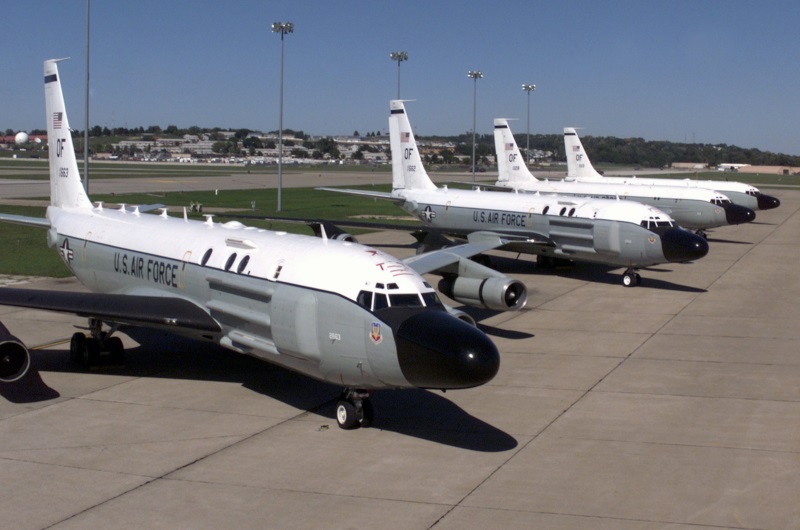
The Cobra Balls remain in service, having been periodically updated; they now have CFM56 turbofans and glass cockpits. Their home base is now Offutt AFB, the Shemya operation having been scaled way back with the end of the Cold War. The Cobra Balls have the thimble nose, receiver systems in cheek fairings, and a teardrop fairing on the rear fuselage. In its present configuration, there are four large portholes in the right forward fuselage for telescopic optical gear, making up the "Real-Time Optical System (RTOS)". It also carries SIGINT gear, particularly for "telemetry intelligence", to get data on missile tests. The right wing is painted black topside, to reduce glare into the optical systems. They have an IFR socket to support extended missions.
There was a single "TC-135C" trainer conversion, to support the RC-135S fleet. It was not fitted with operational systems, presumably being used for flight training; operators could be trained on ground simulators. There was also a single conversion of a C-135B to the "RC-135X" configuration for the "Cobra Eye" program, and flown as part of the "Burning Vision" operation. It was along the lines of the RC-135S, being used to observe missile tests, but lacked the cheek fairings and portholes; apparently it had just one infrared camera. It was converted into an RC-135S in the early 1990s.
There was similarly only one "RC-135E", being a conversion of a C-135B, originally being known as "Lisa Ann" after conversion in 1966, then "Rivet Amber". It featured the hog nose, plus a prominent fiberglass panel on the right forward fuselage, behind the cockpit. The panel hid a powerful phased-array radar; there was a pod on a pylon under each inboard wing, one pod to generate the power for the radar using a Lycoming T55-L5 turbine, the other providing a heat exchanger to provide cooling. It has been occasionally called the "six-engine KC-135", but it was more like 4.5.
The RC-135E flew from Shemya from 1966 under the "Music Blue", later "Burning Star" operation, in cooperation with the RC-135S Rivet Joints to observe Soviet missile tests. It simply disappeared, along with 19 crew, while returning from a mission on 5 June 1969. Various conspiracy tall tales were put together to account for its loss, with suggestions that it was shot down by a missile from a Soviet submarine, but an Air Force investigation suggested it had suffered a structural failure.
The "RC-135U Combat Sent", mentioned earlier, was a reconnaissance conversion, with two aircraft configured with SIGINT systems, side-looking airborne radar (SLAR) in cheek fairings, a distinctive antenna dome under the nose, antennas on the wingtips and tail, plus a litter of antennas on the spine and under the rear fuselage. The most significant SIGINT system was the "Automatic ELINT Emitter Locator System (AEELS)". They were equipped for specialized SIGINT, sniffing out systems that were usually not ON, and transient when they were. As noted, there were three RC-135U conversions from RC-135Cs; two remain in service at last notice, one having been converted to an RC-135W, discussed later. The RC-135Us have been given a series of upgrades, including CFM56 turbofans and modern cockpit layout.
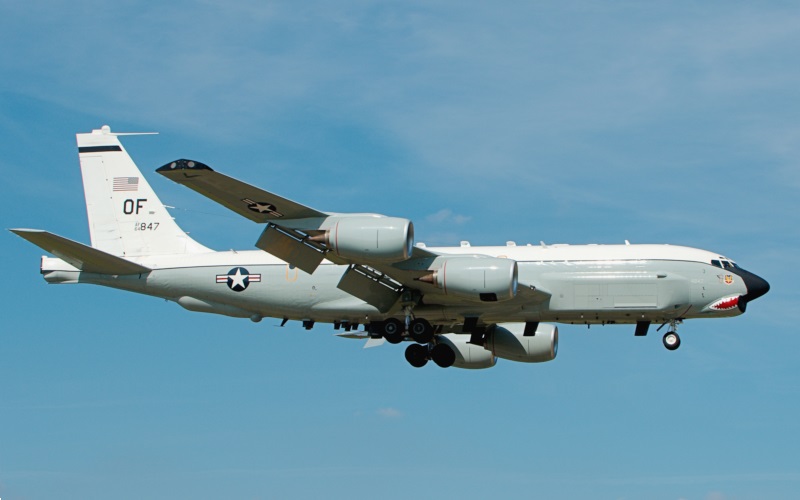
The "RC-135V" was another reconnaissance configuration, associated with the "Rivet Card" program, with a configuration similar to that of the RC-153U, being focused on the SIGINT role. There were six conversions, all ultimately derived from RC-135Cs.
The "RC-135W" was effectively an improved RC-135U, for the "Rivet Joint" program. It had a similar configuration to the RC-135U, but with longer "cheek" fairings, the one on the left overlapping the crew door. There were six conversions originally, along with a seventh conversion to a "TC-135W" trainer, all ultimately derived from C-135Cs. The RC-135Vs were upgraded to the Rivet Joint standard, becoming the same as the RC-135Ws except for their base airframes. It seems they retained the designation of "RC-135V", the distinction being more or less meaningless.
The USAF Rivet Joint fleet later expanded to 17 aircraft, with a ground simulator built for training crews. The TC-135W, incidentally, was only for flight training, with no SIGINT gear: it had the cheek fairings, but they were only fitted to duplicate the flight characteristics of the operational Rivet Joints.
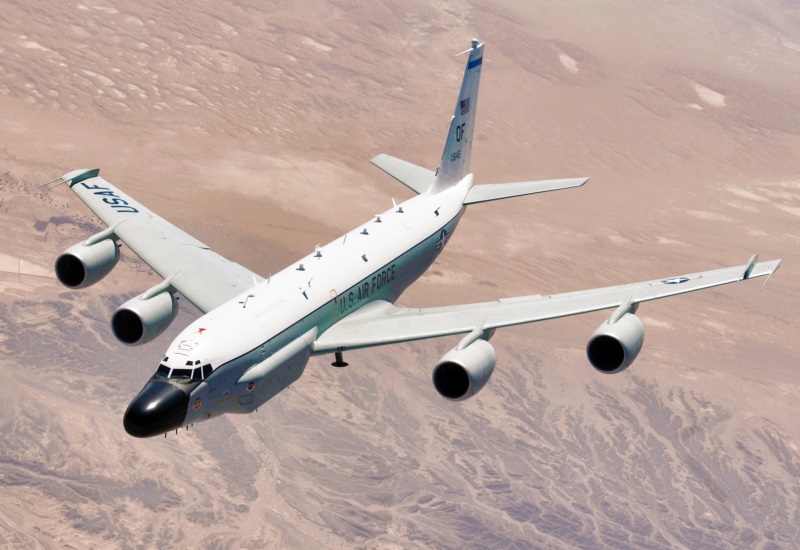
The Rivet Joints remain an important USAF asset, all having been upgraded to CFM56 engines and glass cockpit avionics. Of course, their SIGINT systems have been repeatedly updated. They are significant players in US military campaigns. Three KC-135Rs were converted to Rivet Joint standards, to be handed over to the British Royal Air Force from 2013 to 2017. These are the only RC-135s to ever be flown by a foreign power -- though some export 707s have been configured for the SIGINT mission, the Saudi "R-3A" being hard to tell from a Rivet Joint. The RAF Rivet Joints participated in the Russo-Ukraine War in 2022:2023, performing surveillance on Russian forces. One of them was almost shot down, when a Russian pilot misunderstood orders and tried to launch an AAM at it. The missile malfunctioned.
* Along with the RC-135s, there were also the "WC-135" and "OC-135" machines. The WC-135s were weather reconnaissance aircraft; there were ten of them, converted from C-135Bs from 1965 and redesignated "WC-135B". They were modified for use by the "Constant Phoenix" operation, and they were often called "Constant Phoenix" machines.
The WC-135Bs carried a Bendix AN/AMQ-15 Weather Reconnaissance System, which included weather radars and other instruments, plus "dropsondes" to relay data after being dropped into storms and such. At least eventually, they were fitted with a cylindrical atmospheric sampler above the wing on each side of the fuselage, used to sniff out isotopic traces of nuclear tests. Some source hint that nuclear sampling was or became their primary mission. Two of them monitored fallout after the 1986 Chernobyl nuclear disaster.
The WC-315Bs were also eventually fitted with an optical tracking system, named "Star Cast" or "Cast Glance", to observe missile tests and space launches as a side job. The fleet was gradually drawn down -- three of them becoming "C-135C" VIP transports, including the Speckled Trout, with one retained in the weather reconnaissance role under the designation of "WC-135C", and an EC-135C converted to the same configuration. Three of the other WC-135Bs were redesignated "WC-135W", but apparently that was a grab-bag designation, since the three had different roles. At least one WC-135B became a "TC-135B" trainer. The Constant Phoenix machines have been retired, being replaced with three "WC-135R" machines, converted from CFM56-powered KC-135Rs, with the WC-135Rs delivered in 2022.
In 1992, after the fall of the USSR, the US, Russia, and a number of smaller states signed the "Open Skies" treaty, in which each side flew surveillance aircraft over the other's territory to ensure compliance with arms treaties. A WC-135B was converted into the appropriate US surveillance aircraft, the "OC-135B", which was introduced into service in 1993. It was retired in 1997, apparently having been effectively a demonstrator, and replaced by two OC-135Bs, also converted from WC-135Bs.
The OC-135Bs featured a suite of cameras, and were later fitted with a synthetic aperture radar system; they had a data recording system keeping track of the intelligence obtained. The flight crew included Russian observers. In 2020, faced with Russian waffling, the US withdrew from the Open Skies Treaty, with the two OC-135Bs to be disposed of.
BACK_TO_TOP* This document began life back in 2001, with a survey on battlefield surveillance aircraft that discussed J-STARS. In 2010, I broke up the survey and set up a stand-alone document on J-STARS. A document on the E-3 was released in May 2021, with a document on the 707 released in May 2022; and a document on the KC-135 released in November 2022. I put them all together in the spring of 2023, and released the result as "v2.0.0", following on from the 707 document, in May 2023.
* Sources include:
* Illustration credits:
* Revision history:
v1.0.0 / 01 may 22 / Original 707 document. v2.0.0 / 01 may 23 / Consolidated 707 + KC-135 document. v2.0.1 / 01 may 25 / Review & polish. (+)BACK_TO_TOP
